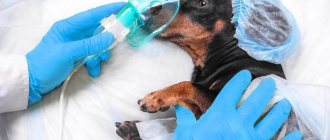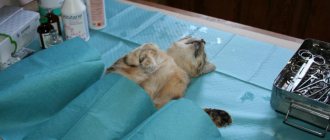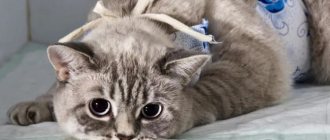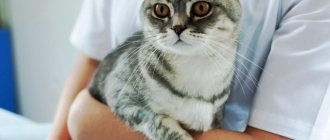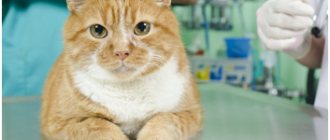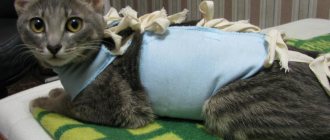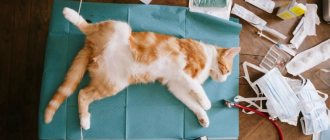Since ancient times, people have been surrounded by cats. They have the status of the most common pet. Pets relieve stress, give affection and warmth, amuse and make you smile. With their purring, emitted in a certain range, they treat their beloved owners. But it happens that cats themselves get sick. And then there may be a need for surgery.
Sterilization is also carried out through surgery. You can't do without anesthesia. What is the first thing an alarmed owner thinks about? Of course, about the risks, complications during anesthesia and surgery. Questions arise: how long does it take for a cat to recover from anesthesia, is it harmful to the animal?
What are the types of anesthesia?
They are as follows:
- Inhalation. A mask is placed on the animal's face, and the gas goes directly into the lungs. It is considered the safest for the animal. The drug is administered through the lungs and eliminated in the same way. The liver and kidneys are not stressed. If it is not possible to administer anesthesia through a mask, you have to insert an endotracheal tube into the cat's throat. If necessary, anesthesia is used. How long does it take for a cat to recover from anesthesia? He wakes up almost immediately.
- Parenteral. Anesthesia is injected into a vein through a pre-installed catheter. It is convenient because the dose of the drug can be accurately calculated and the amount of anesthesia administered to the cat can be controlled. Also, this method allows you to remove the animal from anesthesia smoothly, gradually reducing the dose. In this case, there is a load on the kidneys and liver, and it is these organs that will have to remove the remaining drug from the body. Technically easier to perform, because not all clinics have equipment that allows you to operate under inhalation anesthesia. The animal can sleep for several hours. In this case, both after a complex operation and after sterilization, the cat takes a long time to recover from anesthesia.
Possible problems
Castration is one of the most common and popular operations in veterinary practice. It is worked out in the smallest detail, and in itself is not too complicated.
Intervention in the body is minimal, so postoperative complications are extremely rare. However, the operation and especially the effect of anesthetics can still affect the functioning of the animal's body.
One of the most common problems is constipation. After castration, a cat may not have a bowel movement for several days. This is a dangerous condition, since feces contain toxic and harmful substances, which, stagnating in the intestines, begin to poison the body. Therefore, you need to fight constipation.
You can add a couple of drops of vegetable oil to your cat's food, this will make it easier for the cat to move through the intestines and pass feces.
Under no circumstances should you give your pet human medications to relieve constipation.
Diarrhea after anesthesia is quite rare. Most often, this is how the body reacts to a stressful situation. But sometimes it is a sign of the development of a bacterial infectious disease. If there are other symptoms of infection, the animal should be seen by a doctor immediately.
If your pet had any chronic pathologies before surgery, they may worsen during this period. The owner should closely monitor the condition of his cat and, if necessary, immediately contact a veterinarian.
The most dangerous complications, as a rule, begin to appear within two or three days after surgery. If this period has passed and the cat has begun to eat, go to the toilet and generally behave as usual, then there is no reason to worry.
What are the disadvantages of these types of anesthesia?
When using inhalation anesthesia, the animal's blood vessels dilate, becoming saturated with gas. There may be a risk of a sharp drop in blood pressure. You need the presence of a specialist who monitors all indicators. In addition, if an endotracheal tube rather than a mask is used, there is no possibility of direct access to the respiratory organs. Therefore, this anesthesia method is not suitable for lung operations.
Parenteral anesthesia is dangerous due to its unpredictable effect on the respiratory system. The cat is intubated. This means that during operations on the respiratory organs it is fraught with the occurrence of dangerous situations. In addition, the drugs put a strain on the liver and kidneys.
Both types of anesthesia individually are more suitable for minor operations. If there is a major surgical procedure, anesthesia will most likely be combined or mixed. The first involves using different substances in stages. In the second, more than two drugs are used at once.
Ideal age for castration of cats
Castration of cats can be carried out at any age and at any time of the year, but in the summer it is better not to do it. In the heat, there is a risk of poor healing of a surgical wound due to increased proliferation of opportunistic microflora.
It should also be taken into account that furry males most easily tolerate castration at the age of 6-7 months; in a more mature state of the body, the risk of postoperative complications increases significantly.
- The most common complication is bleeding (drip, moderate and heavy).
- In more rare cases, prolapse of intestinal loops, sepsis, or blood poisoning may occur.
What drugs are used for anesthesia?
There is a very common myth that anesthesia is harmful to animals. This is due to the fact that back in the nineties of the last century, operations on animals were carried out using heavy drugs, from which the pet might not wake up at all. The medications were from the list of narcotic substances. There was at least one accident per ten operations. Complications occurred frequently. Therefore, the attitude towards anesthesia is still wary.
Modern drugs that do not produce such severe consequences are now successfully used:
- Propofol, also known as diprivan and pofol. A lightweight drug that is more suitable for simple operations. The animal instantly falls asleep, sleep lasts about thirty minutes. How long does it take for a cat to recover from propofol anesthesia? Answer: after about an hour it is already quite adequate.
- Zoletil, he is also a domitor. Safe, induces deep sleep, no pain.
- Butorphanol. A drug for strong, long-term anesthesia.
How long does it take for cats to recover from anesthesia after surgery?
The time to recover from anesthesia depends on a number of factors:
- type of drug used;
- dosage of the drug and depth of sleep;
- body weight, age and some individual characteristics;
- state and type of nervous system.
To sterilize a cat, gentle means are most often used, since the operation does not affect deep internal tissues. With the use of modern drugs, recovery time is reduced to 2-3 hours, but uncharacteristic behavior can persist for 3 days. When using potent drugs, the pet can sleep for 8-20 hours.
Preparing your pet for surgery correctly
Before surgery, the veterinarian will examine the animal. Blood and urine tests will be required, and the cat will also be weighed and measured. You will need to indicate the pet’s age and the presence of any congenital diseases. You may have to visit the ultrasound room and have an ECHO of the heart.
Lighter and planned operations are scheduled for the morning. The cat's owner will have to reconsider his daily routine to ensure proper care for her after surgery. This is especially true on the first day. Everything will depend on how long it takes the cat to recover from anesthesia.
Before the operation, food is removed 12 hours, water is excluded 10 hours before anesthesia. This is necessary to prevent aspiration of vomit. In principle, the same requirements are presented to people before surgery. It is safer to perform surgery in a clinic. Take care in advance of transporting the animal home. If the cat cannot be taken to a veterinary hospital, veterinarians can come to your home. However, you cannot bring all the equipment, and sterility at home will not be at the proper level.
Feeding
You should not try to feed your cat as soon as she wakes up. The body is still in a sluggish state, so food that is not properly digested can cause constipation. The cat should not be allowed to strain while going to the litter box, as this may cause the seams to come apart.
At first, the cat will not be interested in food. This is fine. Don't try to force feed her. A weakened body will not be hindered by a day of hunger strike.
Feeding can begin only then. When signs of impaired coordination of movements disappear. The first food a cat eats should be liquid. It is important not to offer your cat unfamiliar food after surgery. This should be your usual food at room temperature.
The best option is a lump of pate, which can be offered to the cat by bringing it to its face. For the first time, half a teaspoon will be enough.
The cat will begin to feel hungry and ask for food only the next day. You need to feed her semi-liquid food in small quantities.
You only need to worry if on the third day after the operation the cat does not eat anything. In this case, you need to consult with the veterinarian who performed the procedure.
What will you need to prepare?
- Carrying is good before surgery. After this, you will not be able to place the animal there without harming it. A box will come in handy. The bottom should be covered with diapers, preferably absorbent ones.
- During the operation, the cat lies with its eyes open. Don’t worry, she doesn’t see or feel anything, it’s just how her body works. Special eye drops will come in handy to prevent the mucous membrane from drying out.
- If the season is cold, prepare a blanket. Wrap the box in it when you go home.
Be sure to ask your veterinarian how long it will take for your cat to recover from anesthesia in your particular case!
It is believed that after surgery it is advisable to leave the pet in the veterinary clinic overnight under the supervision of specialists. But if the doctors are sure that everything is in order and the animal feels more or less normal, after a few hours you can go home. The veterinarian will give recommendations for care.
Drink
You cannot feed your cat after surgery, but you must give water. To avoid dehydration, start giving your pet water immediately after waking up. In the first hours, she will not be able to drink on her own, so it is necessary to drop a few drops of water into the cat’s mouth every half hour.
Until the animal can move confidently, it must be given water on its own. Use a syringe without a needle, dropping a teaspoon of liquid every hour.
There is an opinion that a bowl of water should be left near the bed. However, this should not be done if the owner has the opportunity to water the cat manually. The fact is that a disturbed swallowing reflex will not only prevent the pet from getting drunk, but can also cause the cat to choke or drink through its nose.
Also, the danger of a bowl next to the bed is that the cat suddenly becomes drowsy after anesthesia. He can fall asleep with his face in a cup.
What you should be prepared for
After surgery, a blanket is placed on the cat. It serves as protection against infections and prevents the animal from reaching the stitches. The blanket restricts movement; the cat is already weakened by the operation. Therefore, do not allow your pet to be on high objects - chairs, sofas, and so on. If the cat tries to jump, it may hit the floor and damage the seams. Place a basket or box on the floor and let it sit there.
The animal may be aggressive. Mood swings are common, no matter how long it takes a cat to recover from anesthesia. Provide your pet with peace and quiet so as not to provoke aggression. Children should not approach animals - you don’t want to take care of a child who has been bitten and scratched, do you?
Treat and lubricate the seams, give injections, do everything that the veterinarian prescribed. Failure to follow the recommendations is fraught with unpleasant complications.
The cat may refuse to eat or drink. You can wait a while with food; your pet may even feel sick. But a long-term lack of water in the diet can result in dehydration. Try giving your cat small amounts of water through a syringe.
Proper care and compliance with the doctor’s instructions will help you and your pet cope with the postoperative period. May your pets not get sick and always be healthy!
Possible complications and warning signs
There is always a risk of complications, so be vigilant and notice any changes. Immediately after surgery, it is recommended to monitor the heartbeat, temperature and appearance of the mucous membranes. You should contact your veterinarian if:
- blue or pale mucous membranes;
- prolonged decrease or increase in temperature;
- fast or slow heart rate;
- refusal to eat for more than 2 days (for a kitten – strictly for a day);
- severe nausea (the cat vomits even on an empty stomach);
- persistence of swelling and redness on the wound for more than 3 days;
- the appearance of a hernia - a small compaction under the skin;
- shallow breathing and wheezing.
Also, a visit to the veterinary clinic will be required if a drowsy and apathetic state persists for more than a day. In this situation, it is better to play it safe to prevent more serious complications.
In most cases, the danger of anesthesia is greatly exaggerated. Subject to medical recommendations, taking into account contraindications and preliminary examination, furry pets can undergo surgery under general anesthesia without consequences.


